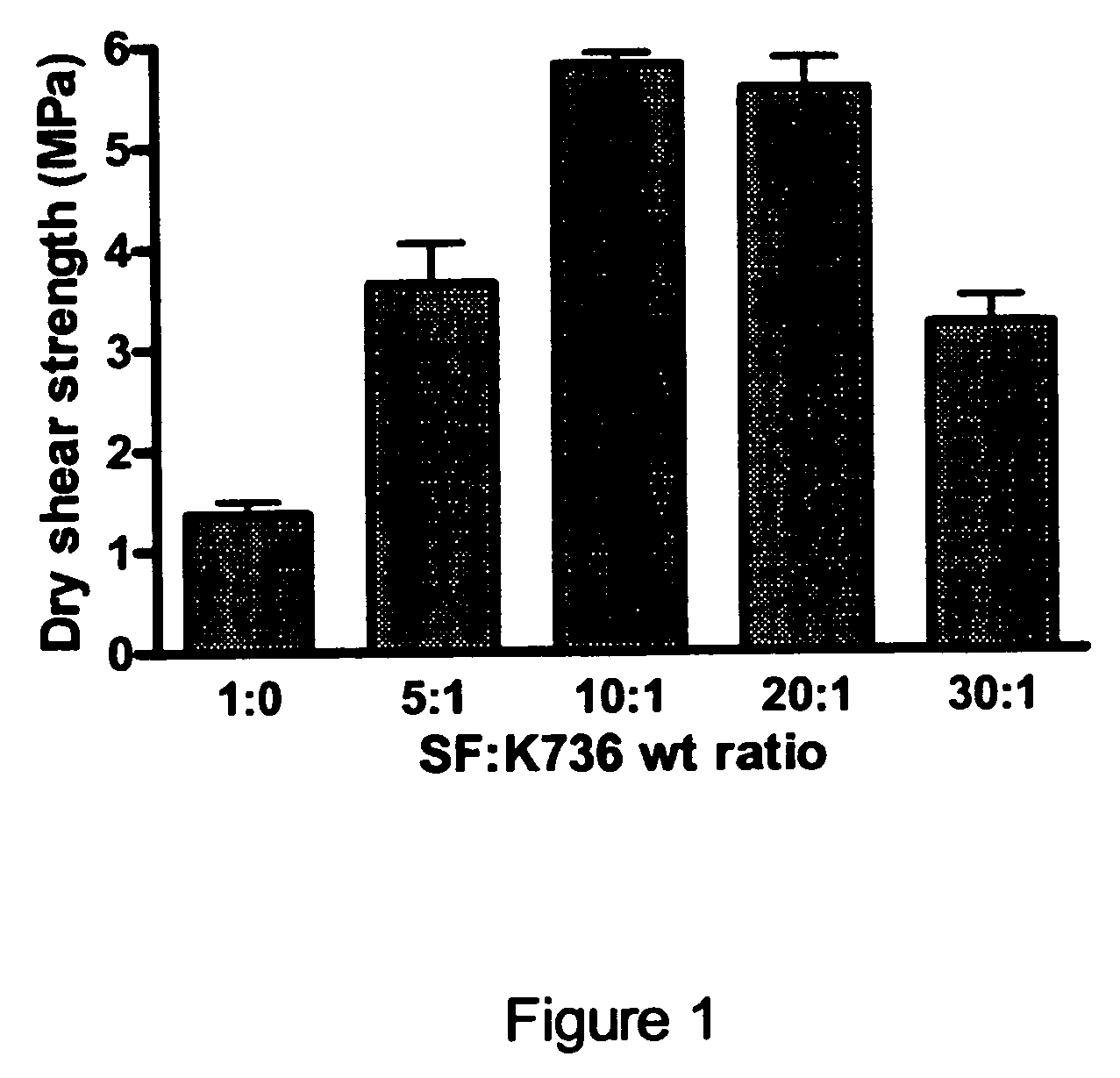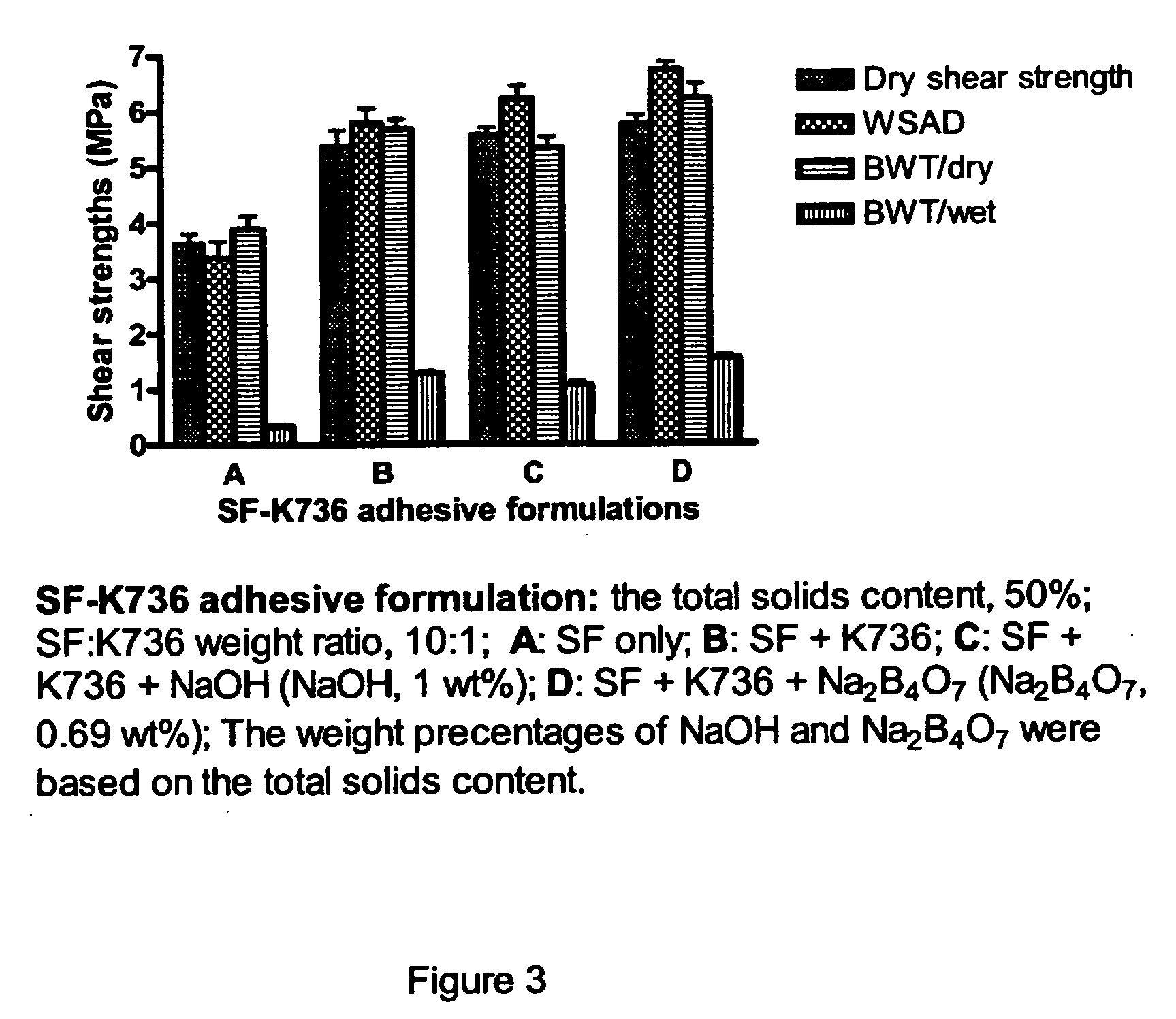Formaldehyde-Free Adhesives and Lignocellulosic Composites Made from the Adhesives
- Summary
- Abstract
- Description
- Claims
- Application Information
AI Technical Summary
Problems solved by technology
Method used
Image
Examples
example 1
Preparation of Adhesive Mixture
Method 1
[0039]Soy flour (SF) (30 g dry weight) was slowly added to 170 ml water in a 600 ml flask with stirring. The pH value of the soy flour slurry was adjusted to about 10 with 50 wt % NaOH solution. The SF mixture was stirred for 20 min and used as a control for bonding maple veneers as described below. A 38 wt % Kymene 736 (“K736”, from Hercules, Inc., Wilmington, Del.) aqueous solution (15.8 g) was added to the alkaline SF mixture. The resulting SF-K736 aqueous mixture was stirred for another 30 min and then used as an adhesive for maple veneers as described below in Example 3. The total solids content of the SF-K736 adhesive was 16.7% and the SF:K736 weight ratio was 5:1. The SF-K736 adhesives with different SF:K736 weight ratios were prepared by adjusting the amount of K736 and water.
example 2
Preparation of Adhesive Mixture
Method 2
[0040]A 38 wt % K736 aqueous solution (12.6 g) was added to 45 ml water with stirring. The soy flour (48 g dry weight) was slowly added to the K736 solution with vigorous stirring. The resulting SF paste was used as a control for bonding maple veneers as describe below in Example 3. Additional examples of adhesives were made by dissolving the 38 wt % K736 solution (12.6 g) and 0.53 g NaOH or 0.77 g Na2B4O7.5H2O in 45.3 ml water. The SF (48 g dry weight) was slowly added to the K736-NaOH solution or the K736-Na2B4O7 solution with a vigorous stirring. The resulting SF-K736 adhesives had 50 wt % total solids content and contained 1 wt % NaOH or 1 wt % Na2B4O7 based on the total solids content. The SF:K736 weight ratio was 10:1. The resulting SF:K736 adhesives were used to bond maple veneers as described below in Example 3.
example 3
Preparation and Testing Wood Composites
[0041]The SF-K736 adhesive mixtures prepared as described in Examples 1 and 2 were evaluated for their ability to bond together two pieces of maple veneer. The adhesive preparation for testing was applied to one side and the end of a maple veneer strip (1 cm×10 cm). Two pieces of maple veneer strips were stacked together and hot-pressed at 120° C. for 5 minutes. The applied pressure was 11 kg / cm2. The bonding area for each two-ply composite specimen was 2.0 cm2. The total spread rate of the adhesives was 9 mg / cm2 bonding area. The lap-shear strength was measured with an Instron TTBML machine with a crosshead speed of 1.0 mm / min using conventional techniques. The maximum shear strength at breakage was recorded.
[0042]The two-ply wood composite specimens bonded with the adhesives were subjected to a water-soaking-and-drying (WSAD) test and a boiling-water test (BWT). For a WSAD test, the specimens were soaked in water at room temperature for 24 ho...
PUM
| Property | Measurement | Unit |
|---|---|---|
| Percent by mass | aaaaa | aaaaa |
| Weight | aaaaa | aaaaa |
| Pressure | aaaaa | aaaaa |
Abstract
Description
Claims
Application Information
 Login to View More
Login to View More - R&D
- Intellectual Property
- Life Sciences
- Materials
- Tech Scout
- Unparalleled Data Quality
- Higher Quality Content
- 60% Fewer Hallucinations
Browse by: Latest US Patents, China's latest patents, Technical Efficacy Thesaurus, Application Domain, Technology Topic, Popular Technical Reports.
© 2025 PatSnap. All rights reserved.Legal|Privacy policy|Modern Slavery Act Transparency Statement|Sitemap|About US| Contact US: help@patsnap.com



